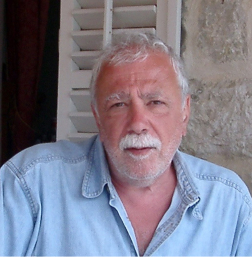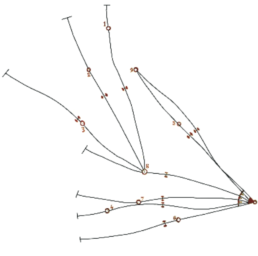Don Foresta
Paris, France
Director of the “art and media” project at the American cultural center in Paris (1971-1976) and first “telematic” exchange with the Center of advanced visual studies at MIT in 1981, then at the Biennale de Paris (1982) and Venice (1986) ). Creator of the first “video art, computer and network” department at ENSAD in 1976. Creator of the MARCEL network.

Biography
Don Foresta is an artist researcher and an arts theorist using new technologies as creative tools. Specializing in art and science, his book “Multiple Worlds” released in 1990 was among the first to talk about the relationship between the two. He was a professor at the Ecole Nationale Supérieure des Arts Décoratifs – Paris and at the Ecole Nationale Supérieure d’Arts – Paris/Cergy and a research fellow at the London School of Economics. He has spent 40 years transforming the network as an artistic tool and is currently working on setting up a permanent high-speed network, MARCEL, dedicated to artistic, educational and cultural www.mmmarcel.org and which now has 350 members. He initiated this project when he was artist/professor in residence at the Studio d’Art Contemporain in Le Fresnoy, Lille and a researcher for the Arts and Humanities Research Council at the Wimbledon School of Art in London. In 1981, he made his first online exchange between the Center for Advanced Visual Studies at MIT where he was a fellow and the American Center in Paris where he was director of the Media Art program. In 1986, curator of the 42nd Venice Biennale, he created the first computer network used by artists. He received a Doctorate in Information Sciences from the Sorbonne and a Master’s from Johns Hopkins School of Advanced International Studies. He was also named Chevalier de l’Ordre des Arts et des Lettres by the French Ministry of Culture and holds dual American and French nationality. Foresta is a member of a think tank, GRAMHONA, at the Collège de France.
Don Foresta's answers
I have been working with art and technology for a very long time, especially in the beginning, it was video in the 70s. I was director of the American Cultural Center, between 71 and 76, where I presented video art for the first time in France. Later, in 1976, I was asked by ENSAD (National School of Decorative Arts) to create a “video art” department. I worked with that (the video), of course, in the 80s, it was a bit towards computers and also the network.
I made a first exchange between the American center in Paris and MIT (Massachusetts Institute of Technology), in 81, which was my first experimentation with telematics as a space for art. And since then, I have stayed with that, following all the technological developments in telecommunications. With the Paris Biennale in 82, with the Venice Biennale in 86 where I created a computer network using Macs and modems and from that I stayed with IP, with Internet Protocol as our base.
And again, I was compelled to follow the evolution of technology and the possibility which was always very, very limited. But still, we managed to do some pretty interesting experiments. Today, this technology reaches the height of our dreams. For the first time, we continue to experiment. We are starting to create our own platform for artistic experimentation, to occupy part of the network, as a space for creation, as a space for exchange and interactive creation.
Like I said, ultimately, we’ve been dreaming about networking possibilities since the ’80s. But technology was always way behind, behind our dreams, as I said. We imagined things that were technically impossible at the time, even when we were a little advanced in France. What is good in France, we had the first digital networks which were at the time Numéris, which was a technology which was introduced in 87. And we worked with this technology quite systematically for a very long time. For almost 15 years, by grouping the lines, we used, for example, during the 1980s, five Numéris lines. There were three for video and two for sound. And we managed to work, for example with the musician in real time and when I tried to do something more than the music, for example, I think it was 93 with the dance, it was impossible. The pipes were too limited and you couldn’t. Well, now we have much, much more important tips. Which means that we can imagine experimenting in a much more complex way.
I believe that training should go in 2 directions, there is always a technology to be developed, which means that there is technical engineering training which is extremely important. And there is of course the fundamental artistic experimentation and the two must really work together.
The interaction I’m working on now is really to bring the artistic professions, especially performance, theatre, music, dance into the space of networks, which means that there is a part learning to understand how we can bring these professions into this virtual space of networks, because it is not easy. And in that sense, the projects that we are setting up in France and also in England are projects to work with theater people, for example.
How can we bring theater professions into this new space which is the space of the network?
We want to work with people who are not technology specialists, but more theater specialists to show them the potential and to identify the tools needed to do their job in the network space. In this case, that is a fundamental part of the pedagogy of the future. And of course, there is a technical development in parallel. When we can identify the technical needs coming from non-technical specialists, we will understand what tools are needed.
Often, in engineering schools, there is already a problem presented and you have to find the solution and it is really the opposite that you are looking for. Another element that I can say in pedagogy is the story. Good when you follow all this evolution that I have lived for 40 years now. We are beginning to understand how things can evolve and I believe that the history of this artistic experimentation with the means of communication, of telecommunications, there are really lessons that are obvious.
We see, indeed, we tried that because we had an artistic objective and not a technological objective. And this artistic goal could not be pursued by the technical limitations at the time. And we learn a lot. And for me, what happened in the 90s was a diversion of the potential that existed. Because everything that we call social networks today, which for me is a perversion of the potential that existed in the 80s. Me, I always say that I was optimistic of telecommunications of the 80s, which had stopped abruptly in the 90s, when it was taken by trade and limited. And we are living with something that is socially almost dangerous and that was not at all in the artistic imagination of the 80s. In this case, I would like to come back to that and I believe that we can come back to that by following the history, the history of artistic creation with telecommunications.
And that is an element that is probably quite essential in pedagogy, because we are trying to climb. First of all, all these forms of art, the living arts, and they still have a long tradition where the trades have existed for a very long time. For example, with the theatre, there are the directors, the actors. There are writers, there are scenographers, lighting. There are all these professions which are not necessarily professions which use technology and which use computers, except more and more today, that’s for sure. But you really have to learn what tools are needed in this new space, and it’s not that new. But hey, we can always say that and really create together the tools necessary to work alternatively in this space. And as I said, it’s something that must exist in parallel, where there is this permanent dialogue between the artistic professions and the technical professions, and not just the network. But everything around IT, programming, development… Because all the network tools that exist, even the tool that we are using now, it stops at the connection and that’s good. It’s better than it was even two years ago. But just logging in is not enough. You have to have the tools to work together. And that is not yet the case.
In an educational form to make people understand that we are far away, of course, we can connect a lot of people, in multipoint. But we can’t work together. Our notion of virtual space now is super limited, as I said. We stop at the connection and we can do many, many more things with our connections. We certainly have the necessary flow. That’s no longer a problem, but we really need to experiment with this space with a lot more online conferences. You really have to find a way to get people to think much more deeply about potentials, about interactivity, real-time interactivity. And I think that’s the most important thing in front of us now.
We do not know !
People always ask for a purpose and we don’t know the purpose of all that. We must enter a period of open experimentation. To understand this space much better and above all to bring non-technological specialists to understand and use this space and there is this collaboration which is absolutely essential for me, otherwise it is the technology which imposes, which imposes rules and that is a rhythm that we want to break.
Because if we are still waiting for tools from others who are not art specialists, who are not specialists in the performance arts, we will always be at the mercy of this development which is much longer.
For example, when I tried to work with the telecoms, I immediately understood that the telecoms weren’t at all interested in the same thing as me because they were in the process of creating a product for the public, a product that was going to bring in money.
And us, it’s totally different. We are experimenting. There may be in the future, potentially products that may have commercial value, but that is not our objective. Which means that we have to work ourselves in our field and imagine a very, very different space from that offered by telecoms, for example, to really experiment and see what tools are necessary and together to build these tools.
Interactivity was something pursued by artists throughout the 20th century, but certainly it was much clearer in 20th century art history that interactivity was something sought by artists where the tools did not exist at all. There were always attempts. It’s a bit like the formula proposed by Duchamp, when he said that “art has two poles, there is the artist who creates and the spectator who interprets it”, and that is already a formula. interactivity which is absolutely fundamental. And you see examples throughout the twentieth century that people, whether they were doing explicitly or implicitly, interactivity was still something they were looking for. How can we bring the viewer into the work?
Well, now we have this potential, we have the tools and we have to experiment with it. But as I always say, that we have a form of open experimentation because we cannot predetermine the results, and that is what is important and even educational. Pedagogically, it’s very, very different because it means that teachers and students are learning at the same time. And our traditions of the time are there to give known things to students and this is no longer the case. We invent together!
It depends on the person. This mix of knowledge that we are looking for is not obvious. That is something to be expected. And I think that’s the reason for our conversation, to try to find the formula to prepare people for this area. But the most important thing is really that people can know that it’s open. We cannot predict the purpose of this research space, it is really a completely open research.
We are exploring this space with the idea in mind that this space is compatible with real-time interactive creation and to see what technologies are needed to do so. But one cannot determine these technologies from a single direction. It’s really multidirectional and we have to do it in collaboration with everyone.
It’s working with the performance arts.
Because when I started in the network in 81 for 10 years, all we did was exchange still images. In this case, we made a kind of exquisite corpse. And at the end of 10 years, I said to my associates “well, we’re bored”, we’re boring, we’re always doing the exact same thing with different images, but artistically, it was the same formula “Exquisite Corpse”. And we decided, it was in 90 to try to work with music, it was very, very complicated, very, very difficult because of the lack of speed.
But all the same, we experimented, as I said, we had Numéris at the time, which gave us a little more scope for experimentation. But still, it was extremely, extremely difficult. But in my opinion, that’s what’s important, it’s having people from these different professions that we need to advance this experimentation and ultimately this form of artistic expression. Here, there are several dimensions. In this case, the first dimension is a work between the artistic side and the technical side.
But behind that, there are other things too. Because there is a certain behavior. You need to learn. I also work on the concept and legal ideas, because that too is extremely important to “Promote” everything we do online.
But mainly, it’s this first step which is really to put together the artistic side and the technical side.




